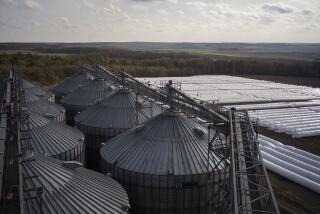Drought Only Postpones a Worse Pain: U.S. Farmers Outgrow World Demand
- Share via
NEW YORK — President Reagan, Michael S. Dukakis and George Bush have all made the obligatory pilgrimage to the drought-stricken Midwestern Grain Belt, donned their tractor caps and promised to “ease the pain,” if not actually send rain.
Grain commodity prices continue to veer up and down in response to each day’s weather report and congressional agricultural committees, peopled entirely with farm-state representatives, are falling all over themselves discovering new ways to send money to their constituents. The current betting is on a bill to pay farmers up to $100,000 per farm at a total cost of perhaps $7 billion.
Lost in the “Grapes of Wrath” rhetoric of dying livestock, dust bowls and burnt crops is the simple fact that world grain stocks are so huge that losing almost an entire year’s production would make little real difference. The U.S. government holds an eight-month surplus of corn; the Department of Agriculture projects that the drought will, at worst, halve that surplus. And even with the drought, world wheat supplies are still expected to rise by 2% this year.
To put it brutally, if the taxpayers are lucky, the drought will continue for the rest of the summer, and the government will have the opportunity to run down its enormous grain stocks, purchased at a cost of about $20 billion annually in recent years. It will be much cheaper to make drought relief payments to farmers than to keep buying unwanted grain.
Since the start of the Reagan Administration, the government has spent almost $90 billion in direct aid to farmers, almost all to agricultural corporations, a sum that dwarfs much more publicized bailouts like those for Chrysler and Lockheed. Not incidentally, $90 billion is roughly the same as the amount spent on welfare programs--Aid to Families with Dependent Children--over the same period.
By legend, farmers are the most upstanding and independent of U.S. citizens. To understand how they became such denizens of the public troughs it is necessary to go back 15 years or so to the great commodity crises of the 1970s.
The United States, for many years, has been the Saudi Arabia of food. It is the world’s swing producer of grain--the only country that can produce, year after year, vastly more food and animal feed grains than it needs for home consumption.
Canada, Australia and Argentina are also excess producers but their total production is a fraction of America’s. In the world of grain commodities, they are the Venezuelas and Omans to America’s Saudi Arabia. Over the past decade, roughly 30%-40% of world grain reserves have been held in U.S. silos, and in some years the United States has sold half the grain traded on world markets. Other producers can affect prices at the margin, but the United States has always been the dominant world grain player.
To a certain extent, the coincidence of the oil and food crises in the early 1970s was just bad luck. There were droughts throughout the world in the first years of the decade, and, in 1972, the huge schools of anchovies that had always appeared off Peru’s coast mysteriously disappeared; along with them went about 2% of animal-oil feed supplies.
But malevolent coincidence rarely operates so neatly. When luck is so unaccountably bad, on such a massive scale, government policies are usually at the root of events. Just as with oil, governments throughout the world, particularly in developing countries--Brazil, India, China, the Soviet Union--had been encouraging food consumption, particularly meat consumption, for their politically volatile urban masses. Meat production creates an illusion of economic progress. But it is expensive: It takes about three pounds of grain protein in the form of feed to produce one pound of meat protein.
The improvement in urban food standards was usually taken out of the hides of farmers, as government marketing boards commandeered grain and other crops at extortionate prices. Not surprisingly, farmers who liked to eat meat, too, joined the exodus to the cities to get their share. In the Soviet Union, the market distortions sometimes grew so severe that farmers could feed bread to their livestock more cheaply than grain.
Bad weather and bad policy combined to triple grain prices between 1970 and 1974, after they had fallen steadily in real terms since World War II. Leaping at the opportunity, U.S. farmers doubled their output between 1972 and 1978. In the good years, half of U.S. corn production went overseas, almost all for animal feed. Even with the high inflation of the 1970s, real farm cash flows doubled. Midwest land values soared, and callused sons of the soil began snapping up air-conditioned self-propelled combines like Arab sheiks buying Mercedes limousines.
The bonanza could not last. Markets have a way of forcing adjustments. Just as the United States made the painful adjustments necessary to halve the world price of oil, the rest of the world adapted its appetites and farm policies to the soaring price of grain. The most dramatic transformation has been in China. When Deng Xiaoping’s reformers released Chinese peasants from the heavy hand of the communist bureaucracy, grain production soared from about 250 million metric tons in 1978 to 350 million metric tons in the mid-1980s. China now rivals the United States as the world’s largest producer, having achieved virtual self-sufficiency, and may soon contend for the valuable Japanese export market.
Improvement in India has been less dramatic, about 25% in the same time period; but that country, too, has achieved self-sufficiency. In the European Community, member countries shifted from a 10-million-ton net import position in 1978 to a 20-million-ton net export position in 1986. Brazil has massively expanded soybean production, a high-protein competitor of corn for animal feed markets.
The big swing importer is still the Soviet Union. With annual crops in the range of 175 million tons, the Soviets had to import about 40 million tons of grain a year in the late 1970s and early 1980s. No one understands the inefficiencies of Soviet farming better than party leader Mikhail S. Gorbachev, a former agriculture minister whose career was almost ended by the farm failures of the early 1980s. The Soviets’ farming reform has barely begun, but they have been rapidly closing the import gap. U.S. experts expect them to achieve self-sufficiency as early as next year, and possibly become exporters in the not too distant future.
The arithmetic for the U.S. Grain Belt is gloomy and inescapable. The United States produces somewhere between 30%-50% more grain than the world can use. Over the last several years, the Agriculture Department has aggressively attempted to reduce production in return for maintaining farm incomes. Sooner or later the process will have to stop. Large numbers of farmers will simply have to go out of business. The government can afford to be generous during a transition period, but it must be one with a definite ending, for the halcyon days are gone, probably forever.
More to Read
Sign up for Essential California
The most important California stories and recommendations in your inbox every morning.
You may occasionally receive promotional content from the Los Angeles Times.













